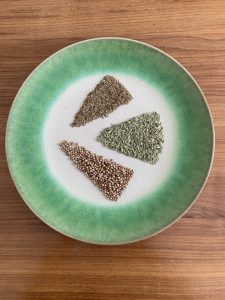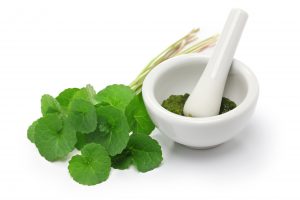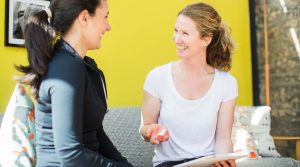An Ayurvedic Cleanse can take on many forms. There is no set guidelines for cleansing and rejuvenating the body. Instead the Ayurvedic approach considers both constitutional type of the individual: Vata, Pitta or Kapha as well as the season.
Any cleanse should work on removing waste (or mala) from the body through elimination of stools, urine and sweat. With this in mind, a short cleanse could take the form of removing toxic food and drinks from the diet: caffeine, alcohol and refined sugar, sipping on warm water throughout the day to stimulate the digestion and encourage bowel movements, and taking part in activities which encourage sweating.
A spring cleanse takes on a more vigorous, energetic approach. This can also be applied to our lifestyle, Yoga practice or exercise. The aim of a spring cleanse is to clear Kapha, or heaviness and stagnation which can accumulate over the winter months. As we consider Ayurvedic type, this would apply more to Kapha type people.
The diet of a spring cleanse would be lighter; tender, fresh green vegetables, which add prana to the body; beans, light grains and bitter herbs and spices to help flush the liver and digestive system of toxins.
 For all constitutional types the the three spices for Agni Deepnana (balancing the digestive fire) are: cumin, coriander and fennel. All three can be used generously when cooking and as a supplement to aid elimination of toxins (Ama Pachana) from the body.
For all constitutional types the the three spices for Agni Deepnana (balancing the digestive fire) are: cumin, coriander and fennel. All three can be used generously when cooking and as a supplement to aid elimination of toxins (Ama Pachana) from the body.
In both Ayurvedic cooking and therapy the use of spices and oils plays a major role in maintaining balance.
During a cleanse or whenever you feel your digestive system is upset, Ayurveda recommends a light, nourishing meal of Kitchari. There’s no set recipe for Kitchari, we can however adapt the basic ingredients to suit each Ayurvedic type. The foundation of Kitachri is rice and mung beans. The qualities of which are adapted to each type.
Basic Kitchari Recipe
These quantities make enough for lunch and dinner.
- 50g yellow mung dhal
- 50g basmati rice (adapt the ratio according to Dosha)
- 1tsp each of ground cumin, coriander and fennel seeds.
- Add any other spices from your recommended list.
- Ghee or coconut oil. According to Dosha.
- 1/4 tsp rock salt
- 500mls water
Heat Ghee and add spices. Fry for a few minutes. Add mung dhal, and 500mls water. Cook for 5 mins then add rice. Cook until rice and beans are soft.
For any Ayurvedic treatment, clinical trials are standard. We try things out and observe and feel the effect the have on us. You may notice changes in your toilet habits, energy levels, the coating on your tongue, and skin.
Ayurveda is not a quick fix. It’s treatment should not be aggressive. We observe subtle changes to our physical and emotional wellbeing. If you experience a sudden, severe reaction e.g. nausea or severe tiredness, you may not me supporting your body through the cleanse. It’s OK, to take things a little slower to find out what works for you.
Here are considerations for each Ayurvedic Type and the most suitable spices for each Dosha.
The spring cleanse for a Vata type person would be more nourishing. Not too many beans as they have stringent (drying) qualities which can aggravate Vata. The ratio of mung beans: rice would be 1:2. Warming spices and light grains, with oils and cooked green vegetables. Add moisture to food in the form of light soups and stews.
Fasting is not recommended for Vata or Pitta types. Three regular meals and no snacking will suit both types more.
Vata Herbs, spices and supplements:
Cumin, Coriander, Fennel, Gotu Kola, Hing, Cardamum, Cinnamon, Cloves, Dates, Eucalyptus, Garlic, Ginger, Liquorice, Marjoram, Mustard seeds, Nutmeg, Oregano, Paprika, Parsley, Rose, Saffron, Sage, Star anise, Tamarind, Tarragon, Thyme, Turmeric. Watercress.
These spices can be added generously to your Kitchari, especially cumin, coriander and fennel. Asafotida (Hing) will enhance the digestibility of the beans. Also add a generous amount of ghee and plenty of water to ensure the kitachri is moist.
Kapha’s spring cleanse should be a little more vigorous and energetic. Kapha should avoid dairy foods, sugar, fats and oils and heavy grains. Beans are great for Kapha as they need the drying qualities from the beans. The ratio of beans to rice should be 1:2 Kapha individuals can add a little more spice to their food from pungent, bitter herbs and spices, boosting their metabolism and slow digestive fire. Warming and stimulating counteracts the cold, stagnant properties of Kapha.
Fasting is more suitable for Kapha types. Having an awareness of appetite is important for Kapha types; only eating when hungry as Kapha is more prone to overeating.
Kapha herbs, spices and supplements:
Ajwain, Anise, Ashwaghanda, Barberry, Basil, Bay, Cardamon, Camomile, Chicory, Cinnamon, Cloves, Cumin, Coriander, Echinacea, Eucalyptus, Garlic, Hing, Lemongrass, Marjoram, Mustard seeds, Nutmeg, Oregano, Paprika, Parsley, Pippali, Rosemary, Saffron, Sage, Star anise, Sumac, Tamarind.
For Pitta individuals the spring cleanse should be stimulating without aggravating Pitta. Pitta possesses oily, hot qualities, so beans and fresh, young alkaline-rich green vegetables are great. The bitter taste of green vegetables is great for Pitta as they add the cooling, balancing quality for Pitta. The ratio of beans: rice for Pitta Kitchari should be 1:1.
Pitta herbs, spices and supplements:
Aloe, Barberry, Camomile, Cumin, Coriander, Chicory, Cardamom, Dates, Echinacea, Fennel, Gotu Kola, Lemongrass, Liquorice, Saffron, Sumac, Shatavari, Turmeric (may aggravate in larger amounts), Neem, Lime.
We can incorporate a short cleanse of a few days each month in to our lifestyle or a longer seasonal cleanse. A short cleanse can last between 3 -10 days, Considering Ayurvedic Type and Season, this is how a Spring cleanse would look:
Day 1: Preparation (day 1-3 if you are doing a longer cleanse)
Removing foods and drinks which create toxins. This includes alcohol, caffeine, refined sugars and carbohydrates, processed food and nicotine. This may take a little longer if you need to slowly wean yourself off some substances like caffeine. Sipping warm water throughout the day will help stimulate the bowels and clear the kidneys.
Gotu Kola is a bitter herb which is balancing for all the Doshas. Infusing the dried leaves to make a tea will help cleanse the blood and detoxify the liver.

Gotu Kola
Day 2: Routine. (days 3-5 if longer) If you are following a cleanse for more than 5 days, take more time to work out a routine which suits your lifestyle.
Try to eat and sleep at regular times. For the majority of the time, eat before 8pm and sleep by 10pm. Try to avoid snacking and take regular exercise or time outdoors. We should try to incorporate this routine for around 80% as standard.
Day 3: Oleation. Oiling the body, both internally and externally helps withe the elimination and cleansing process. Vata types benefit most from oleation due to the dry nature of this Dosha. Ghee can be added to food or used as a carrier for spices and herbs. Drinking ghee can be a little difficult for most people, so adding a little more to cooking is beneficial.
Vata types would benefit from oiling the body with sesame oil, whereas Pitta types are more suited to coconut oil. During a spring cleanse Kapha types would benefit from regular saunas or a dry massage using ground mung beans which is stimulating and would remove excess moisture from the body.
Day 3: Cleansing and strengthening the digestive tract by Agni Deepana (balancing the digestive fire) and Ama pachana (removing toxins). (Day 5-10 for a longer cleanse)
We can use simple remedies such as 1/2 t-spoon dry roasted and ground cumin seeds and honey before meals to stimulate the digestive fire. Taking this before meals is balancing for all the Doshas. Formulated herbs can also be prescribed by your Ayurvedic Practitioner such as Hinguashtika, Paaka Choorna or Avipathikara Choorna, depending on the Dosha and the imbalance.
A light meal of kitachri for lunch and dinner for a few days would be great here.
To help clear the bowels, a gentle tummy massage with sesame oil for Vata and Kapha and coconut oil for Pitta will help stimulate the movement of waste through the digestive tract. Drinking fresh ginger or fennel tea after meals will also help. Making a tea of equal quantities of our digestive spices: cumin, coriander and fennel and drinking after meals will also help. Your Ayurvedic Practitioner may prescribe formulated herbal preparations such as Triphala or Dhatree, again depending on the Dosha and the imbalance.
To help stimulate the urinary tract drinking coriander water: 3 t-spoons of coriander seeds infused in a glass of water overnight and strained and drunk in the morning. Drinking coriander water regularly has lots of benefits for all the Doshas: it’s cooling and cleansing for Pitta, is a mild diuretic, so will help remove excess moisture form Kapha, which is great for a spring cleanse, and has channel cleaning properties for Vata.
Following a cleanse, whatever the season it’s important to slowly reintroduce foods which are suitable for your Ayurvedic Type. Remember Ayurveda isn’t aggressive. Make changes and reintroduce foods slowly.
 Clare is an Ayurvedic Nutrition and Massage Therapist at Lotus Studio, Highams Park. London E4. Clare offers individually tailored nutrition and lifestyle advice as well as oral and herbal preparations to treat: skin conditions, digestive disorders, stress, weight loss, diabetes, menstruation and menopausal symptoms.
Clare is an Ayurvedic Nutrition and Massage Therapist at Lotus Studio, Highams Park. London E4. Clare offers individually tailored nutrition and lifestyle advice as well as oral and herbal preparations to treat: skin conditions, digestive disorders, stress, weight loss, diabetes, menstruation and menopausal symptoms.

